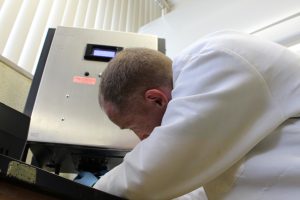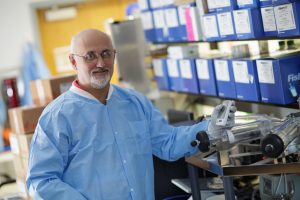After individuals are diagnosed with COVID-19, they are required to quarantine at home. If they live with others, they are encouraged to isolate themselves in a separate room to reduce exposure of the other individuals to the airborne virus.
Researchers at the University of Florida found that residential settings might be hotspots to spread SARS-CoV-2, the virus that causes COVID-19, due to poor ventilation in homes and the relaxed usage of masks. As part of this study, researchers were also the first to demonstrate a viable, or infectious, virus on the surface of a cellphone.

This study, initiated by William (Brad) Vass, a first-year doctoral student in the Department of Environmental Engineering Sciences within the Engineering School of Sustainable Infrastructure & Environment (ESSIE), assessed air and surface samples for the presence of SARS-CoV-2 from a self-isolating student with COVID-19.
“People spend a lot of time in their homes, and when a person in a home gets sick, others have difficulty avoiding the sick person. Understanding where viable viruses can be detected in residential environments can help us better inform the community about preventing virus exposure in homes,” Vass said.
Vass wanted to conduct research in a residential environment with a self-isolating individual with the illness to understand whether the virus is present in the air and the extent to which it spreads. He worked with Chang-Yu Wu, Ph.D., a professor in ESSIE and mentor; John Lednicky, Ph.D., a professor in the Department of Environmental and Global Health at the College of Public Health and Health Professions and a member of the Emerging Pathogens Institute; and Hugh Fan, Ph.D., an Excellence Term Professor in the Department of Mechanical & Aerospace Engineering.
This project was funded by a $1.4 million grant from the National Institutes of Health’s (NIH) National Institute of Allergy and Infectious Diseases (NIAID) led by Dr. Fan and a sub-award from Aerosol Dynamics Inc. to UF through NIH’s Small Business Innovation Research Program (NIH SBIR).
Field Sampling
Dr. Wu’s research team, led by Vass, used a device to carefully collect air samples around the student’s home. The team found that virus particles collected during sampling remained capable of causing infection. The device uses water molecules to coat and enlarge the particles for virologists to assess in the laboratory in a process similar to research conducted in 2020.
Vass also collected surface samples from items inside the student’s bedroom — their cellphone, laptop, chair arm — along with surfaces outside of the bedroom — a table and a desk across the residence — to test whether the virus was transported to parts of the home beyond the isolation room.
“Environmental surveillance is a powerful tool that allows us to understand whether the virus is spreading at a select location, and often, how it does, so that we can set better mitigation measures to lower the exposure risk to the public,” Dr. Wu said.
Sample Assessment

Vass transferred the samples to Dr. Lednicky for further study. Dr. Lednicky detected the virus by real-time reverse transcription polymerase chain reaction (RT-PCR), quantified the amount of virus present in the samples, isolated the virus in cell cultures, and interpreted the significance of the genetic sequences.
The team’s findings indicated that airborne SARS-CoV-2 delta variant was present near and beyond 6 feet of the infected student. The virus spread beyond the room throughout the home.
“Most aerosol research related to COVID has focused on what happens in hospitals and public spaces. But the real concern now should be trying to understand what happens in the homes of people with COVID patients,” Dr. Lednicky said. “Our work was one of the first to examine the potential risks of breathing air in a home housing a COVID patient. Moreover, the virus was a delta variant, which is more easily transmitted person to person. Before, there was little information about the virus in air samples. Our work shows that it is present in the air.”
The virus was also detected on the student’s cellphone. Until now, no one has detected the virus live from a surface; before, the viable virus was only detected from air particles.
“This is the first-ever real-world report of the viable SARS-CoV-2 collected from the surface of a cellphone,” Dr. Wu said. “If an individual touches the contaminated surface and then inadvertently touches their eyes, nose or mouth, the viable virus gets a chance to enter the human body, which is called ‘fomite’ transmission. So, people must be careful not to touch each other’s cellphones, as the exhaled breath (like from talking or coughing) onto the phone by an infected individual can pass the virus to them through this way.”
Future Research
The research team hopes to sample more residential areas for data points, which will help identify ways to reduce the spread of coronavirus. This research also has the potential to expand beyond SARS-CoV-2 detection to learn how other respiratory viruses, such as influenza viruses, would spread similarly.
“We hope that the public will use this study, and others in a growing body of research related to respiratory viruses in aerosols, to help themselves make decisions about how best to protect themselves and others when someone in their home becomes sick from a respiratory virus,” Vass said.
To read the full study, visit https://doi.org/10.1016/j.jaerosci.2022.106038.
—
By Reba Liddy
Marketing and Communications Specialist
